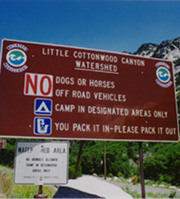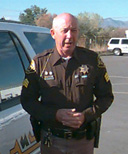Watershed Law Enforcement
Protecting water quality at its source ensures safe drinking water.
November 6, 1998
|
Salt Lake City’s watershed areas are designed as:
- All of Little Cottonwood Canyon
- All of Big Cottonwood Canyon
- All of Parleys Canyon, north and east of Mountain Dell Dam, included Lambs and Dell Canyons
- City Creek Canyon
In these canyon areas, the Salt Lake Valley Health Department, US Forest Service, Salt Lake County Sheriff, Alta Marshalls and Watershed Officers of the Salt Lake City Department of Public Utilities enforce watershed ordinances. Violations constitute a Class “B” misemeanor.
City Creek is within the corporate limits of Salt Lake City and is subject to all Salt Lake City Ordinances.
|
It is unlawful for any person:
- To permit a dog(s) to be taken into the watershed area. This does not apply to seeing eye/hearing dogs or law enforcement dogs.
- To pollute or allow pollution of any water in the watershed areas.
- To operate any type of motor vehicle upon any property within the watershed (without permission) except on a highway or road open for public use, approved roads in residential/cabin areas, official picnic/camping area roads, and ski area parking lots. Emergency and official government vehicles are exempt when on official business.
- To deposit any human excreta within the watershed areas other than into approved toilets. Cesspools are prohibited.
- To permit a horse or any other domestic animal into the watershed area without a permit.
- To camp overnight except in officially designed campgrounds. This does not apply to backpacking.
- To backcounty camp unless the campsite is located over 200 feet from the nearest water source, and 1/2-mile from any road.
- To bathe, swim or wash clothes, diapers, eating utensils or any other object in any spring, marsh, stream or other water source.
- To throw or beak glass.
These regulations apply in the entire canyon watershed areas from ridge top to ridge top, not just in the immediate area of surface water.
|
According to Salt Lake County Sheriff records, the percent of watershed violations are camping 46 percent, dogs 44 percent, off-road 6 percent and others 4 percent.
Questions about watershed regulations should be directed to Russ Hone at 801-483-6705. Or e-mail: russ.hone@ci.slc.ut.us


